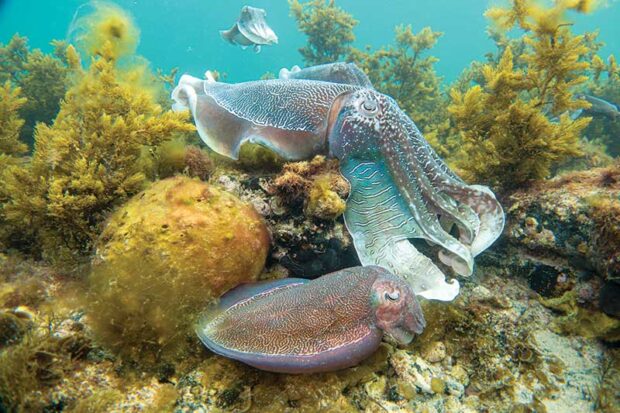When citizen scientists get angry
By Heather Creech

In citizen science, there comes a moment when recording observations simply isn’t enough to protect the ocean we love—when it becomes necessary to dive headfirst into the politics and economics of marine conservation. That time has come in South Australia. Divers, scientists, and many others (including this writer) have joined the Cuttlefish Alliance to challenge the lifting of fishing restrictions on one of the great marine wonders of the world.
From June to August every year, hundreds of thousands of giant cuttlefish migrate from across the southern ocean into the Upper Spencer Gulf to display their colours, compete for a mate, spawn and lay eggs in the shallow rocky reefs, and then, finally, die. It all takes place in only a few metres of water, just 100 feet (30m) from the shore. So spectacular and unique is this event that David Attenborough filmed it for Blue Planet II. Thousands of people come from around the world to the small city of Whyalla to view the aggregation, contributing tens of thousands of tourist dollars to the local economy in the process.
And then in 2013, the giant cuttlefish almost didn’t come back. Scientists don’t know why the population numbers collapsed, but temporary fishing restrictions were put in place and the Cuttlefish Reference Group—the body that advises the State—met annually to review the situation.
Fishing and subsequent collapse
This year the aggregation finally returned to its full glory: between one and two hundred thousand cuttlefish swimming into the shallows to dance, fight, and mate. But as the cuttlefish have returned, so has the demand to harvest them. There is a small export market for cuttlefish but in general it is a low value product, used primarily for bait. The fishing restrictions were lifted by the State, leaving only a small permanent exclusion zone where reproduction occurs. Commercial and recreational fishers lined up to pull out cuttlefish on their way into the zone, by the boat full.
On 12 July 2020, mid-way through the aggregation, snorkellers entered the water at the Point Lowly Marina in Whyalla to find that there were no giant cuttlefish left to be seen.
Outrage has swept across the city and the State generally: the businesses dependent on cuttlefish tourism have lost money, divers and snorkellers are crushed, marine environment advocates are furious. But the State department responsible for fisheries is holding firm to the position that the science indicates there are sufficient numbers to support a sustainable cuttlefish fishery. Thousands of South Australians disagree.
When citizen scientists get angry, they reach for the tools of protest: Raising mass awareness, compiling background and evidence, and leveraging political influence. Two petitions are underway, one electronic directed at the department and one hard copy for tabling in the State parliament. Sustained social media campaigns, media releases, interviews, and letters to the editor are all being deployed.
State position challenged
Both the science and economics of the government’s decision have to be challenged. The science is not in fact clear—cephalopod population levels can change rapidly for unknown reasons and the giant cuttlefish population is considered particularly vulnerable because they are so easy to fish out, given that they all show up at the same time, in the same place. The economic value of the cuttlefish harvest is limited and may not be anywhere nearly equivalent to the tourism value of the event. Reduce the impact of the spectacle through fishing and you reduce the level of tourism.
The Cuttlefish Alliance has convened its own panel of experts to develop a more cautionary position for consideration by the State. Its hope is that a review of the science and economic arguments, as well as genuine public concern about a unique South Australian phenomenon, will lead to change. If a wholesale ban on cuttlefish fishing is not possible, there may be a compromise: improved and consistent monitoring of cuttlefish populations, and enforced restrictions and exclusion zones at certain times of year, especially during the migration/mating season.
Finding that pathway forward will need all the help possible from citizen scientists and lovers of marine wonders in South Australia and around the world.
Follow the Cuttlefish Alliance on Facebook @cuttlefishalliance
Sign the petition at www.change.org and search for ‘cuttlefish aggregation’.







